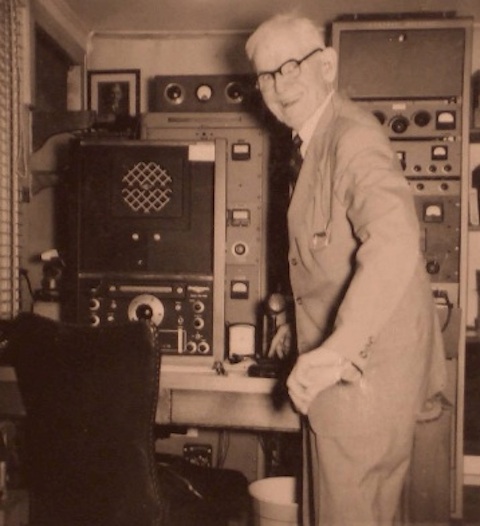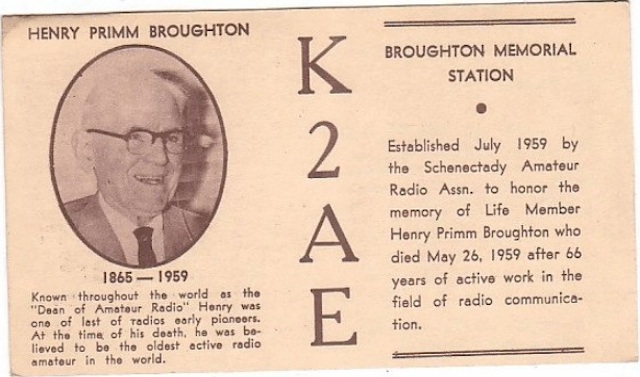Nikola Tesla the founder of Radio Technology and of Wireless Communication
During his 1873 lecture in St. Louis, Nikola Tesla showed for the first time in history the fundamentals of Radio Technology and of Wireless Communication. This is described in detail by Margareth Cheney in her monograph Tesla / Man Out of Time (published in 1981), in Chapter 6 entitled "Radio".
From that monograph, we learn that during his public lecture in St. Louis, Nikola Tesla had the assistant Henry Primm Broughton (1865-1959). Henry's son William Gundry Broughton (1902-1994), in his public lecture in 1970s, informed about experiments assisted by his father Henry, proving without any doubt that Tesla should be credited for the discovery of Radio Technology and Wireless communication. See Chapter 6 ("Radio") of the aforementioned monograph by Margaret Cheney.
Here, we quote the following short passage from her book:
On August 31, 1892, The Electrical Engineer reported the return to New York of Mr. Nikola Tesla, the distinguished electrician, on the steamship Augusta Victoria from Hamburg. After commenting on the death of Tesla's mother and his subsequent illness, the journal added: "His magnificent reception at the hands of European electricians has become, like his investigations and researches, part of electrical history; and the honors conferred on him were such as to make Americans very proud of one who has chosen this country as a home."
He moved scientific history forward again in the spring of 1893 when, addressing the Franklin Institute in Philadelphia and the National Electric Light Association at St. Louis, he described in detail the principles of radio broadcasting.
At St. Louis he made the first public demonstration ever of radio communication, although Marconi is generally credited with having achieved this feat in 1895. Tesla's twenty-eight-year-old assistant at the St. Louis lecture was H. P. Broughton, whose son, William G. Broughton, is licensee of the Schenectady Museum memorial amateur radio station W21R. At the station's dedication speech in 1976 William Broughton touched upon highlights of Tesla's historic demonstration at St. Louis - after a week's preparation - as personally told to him by his father.
"Eighty-three years ago, in St. Louis, the National Electric Light Association sponsored a public lecture on high-voltage high-frequency phenomena," said the younger Broughton. "On the auditorium stage a demonstration was set up by using two groups of equipment. "In the transmitter group on one side of the stage was a 5-kva high-voltage pole- type oil-filled distribution transformer connected to a condenser bank of Leyden jars, a spark gap, a coil, and a wire running up to the ceiling."
"In the receiver group at the other side of the stage was an identical wire hanging from the ceiling, a duplicate condenser bank of Leyden jars and coil - but instead of the spark gap, there was a Geissler tube that would light up like a modern fluorescent lamp bulb when voltage was applied. There were no interconnecting wires between transmitter and receiver. "The transformer in the transmitter group," Broughton continued, "was energized from a special electric power line through an exposed two-blade knife switch. When this switch was closed, the transformer grunted and groaned, the Leyden jars showed corona sizzling around their foil edges, the spark gap crackled with a noisy spark discharge, and an invisible electromagnetic field radiated energy into space from the transmitter antenna wire.
"Simultaneously, in the receiver group, the Geissler tube lighted up from radio- frequency excitation picked up by the receiver antenna wire. "Thus wireless was born. A wireless message had been transmitted by the 5- kilowatt spark transmitter, and instantly received by the Geissler-tube receiver thirty feet away.... "The world-famous genius who invented, conducted, and explained this lecture demonstration," he concluded, "was Nikola Tesla."
Although the St. Louis demonstration was no "message sent 'round the world" as Tesla would doubtless of course have preferred it to be, he had nevertheless demonstrated all the fundamental principles of modern radio:
- an antenna or aerial wire;
- a ground connection;
- an aerial-ground circuit containing inductance and capacity;
- adjustable inductance and capacity (for tuning);
- sending and receiving sets tuned to resonance with each other; and
- electronic tube detectors.
Henry Primm Broughton K2AE (1865-1959)
Electrical & Mechanical Engineer, BS Cornell Univ 1890
At the time of Mr. Broughton's death it was determined he was the oldest active hamoperator in the world.

Henry Primm Broughton, distinguished American radio-amater,
and Tesla's assistant in St. Louis during his lecture in 1893.
Source: www.oldqslcards.com/K2AE.pdf

Margaret Cheney
... The Smithsonian Institution has never adequately credited Tesla for his invention of radio. They have tended to call Marconi the "father of radio," and they have tended to give Edison credit for Tesla's work in alternating current, although Edison didn't work in that area at all. ... Source (Excerpt from an interview).
Nikola Tesla was born in Croatia in 1856, where he lived until the age of 19 (i.e., until 1875). He spent the last two thirds of his life (that is, nearly 60 years) in the USA, where he died in 1943. He also lived in Austria, Hungary, France, Germany, Slovenia, for about eight years.
Literature
Nikola Tesla and Croatians
- Nikola Tesla and his schooling in Croatia
- Nikola Tesla and Croatians
- Nikola Tesla u
gradu Zagrebu 1892.
Nikola Tesla and his schooling in Croatia
Nikola Tesla in the city of Zagreb in 1892
Many thanks to Mario Filipi for his information about Henry P. Broughton, Tesla's assistant in St. Louis.
Mario Filipi: Nikola Tesla Beneath the Cobwebs, 2023, 552 pp.
Croatia, its History, Culture and Science